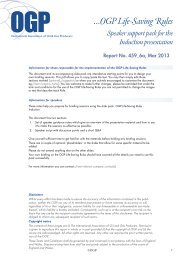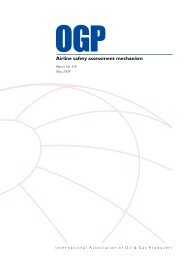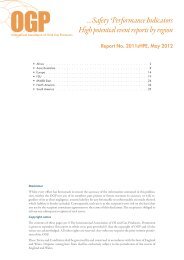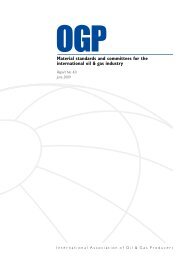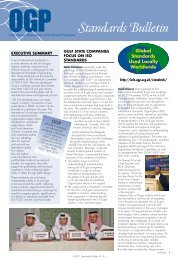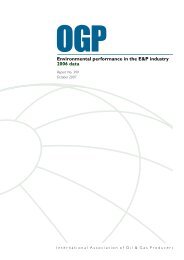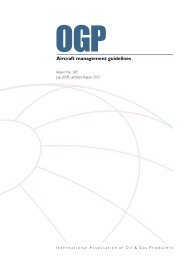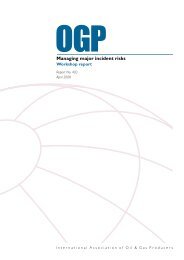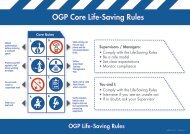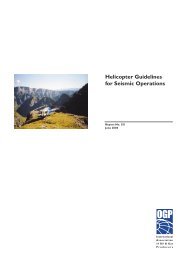Helicopter guidelines for land seismic & helirig operations - OGP
Helicopter guidelines for land seismic & helirig operations - OGP
Helicopter guidelines for land seismic & helirig operations - OGP
You also want an ePaper? Increase the reach of your titles
YUMPU automatically turns print PDFs into web optimized ePapers that Google loves.
<strong>Helicopter</strong> <strong>guidelines</strong> <strong>for</strong> <strong>land</strong> <strong>seismic</strong> & <strong>helirig</strong> <strong>operations</strong><br />
Annex H<br />
Fatigue management programmes<br />
A documented plan should be implemented <strong>for</strong> a Fatigue Management Plan (FMP) by the<br />
<strong>Helicopter</strong> Provider. Due to the nature of <strong>land</strong> <strong>seismic</strong> and <strong>helirig</strong> flying, specifically heliportable<br />
<strong>operations</strong>, pilot workload is high. To adequately address fatigue issues of repetitive<br />
lifting <strong>operations</strong> and multiple <strong>land</strong>ings, it is important that all operators identify areas where<br />
crew may need additional guidance to insure adequate rest and thus mitigate against acute and<br />
chronic fatigue arising from these types of activities.<br />
A fatigue management plan will help to address these concerns as they relate to the operators<br />
specific pilots and engineers. The operator will identify areas where controls need to be<br />
implemented or a variance granted to better suit a particular programme, or geographic area, thus<br />
allowing greater operational flexibility while still maintaining safety sensitive issues that arise<br />
from flight duty/workload and their effects on fatigue. It should be submitted to the Aviation<br />
Advisors during operational planning. This plan should include all air crew (both pilots and<br />
engineers) and any safety sensitive support crews (fuel truck drivers, loadmasters, etc...)<br />
Fatigue can be defined as increasing difficulty in per<strong>for</strong>ming physical or mental activities. Signs<br />
of fatigue include tiredness even after sleep, psychological disturbances, loss of energy and<br />
inability to concentrate. Fatigue can lead to incidents because pilots and engineers may not be<br />
alert and may be less able to respond to changing circumstances. As well as these immediate<br />
problems, fatigue can lead to long term health problems.<br />
Acute fatigue is caused by immediate episodes of sleep deprivation, ie because of long periods<br />
of wakefulness from excessively long shifts which can compound into chronic fatigue (daily,<br />
weekly, monthly and in extreme cases annually) without adequate daytime rest.<br />
Ongoing sleep disruption can lead to sleep debt and chronic sleep deprivation, placing individuals<br />
in a state of increased risk to themselves, their passengers and the general public. It results in:<br />
• Unpleasant muscular weariness<br />
• Tiredness in everyday activities<br />
• Reduced coordination and alertness<br />
If sleep deprivation continues, work per<strong>for</strong>mance can deteriorate even further (chronic<br />
fatigue). As a number of helicopter accidents are directly related to human per<strong>for</strong>mance issues,<br />
establishing an effective fatigue management plan should be a priority.<br />
Causes of fatigue can result from features of the work and workplace and from features of a<br />
pilots/engineers life outside work. Levels of work-related fatigue are similar <strong>for</strong> different<br />
individuals per<strong>for</strong>ming the same tasks. Work-related fatigue can and should be measured<br />
and managed at an organizational level. Non-work related causes vary considerably between<br />
individuals. Nonworking related fatigue is best managed at an individual level. This is where<br />
training and education programmes should be considered by the <strong>Helicopter</strong> Provider to further<br />
allow personnel to recognize individual symptoms and areas that may contribute to either acute<br />
or chronic fatigue outside the work place.<br />
Fatigue management programmes should aim to achieve the following:<br />
• Reduce fatigue and improve the on-duty alertness of pilots, engineers and other safety<br />
sensitive positions.<br />
• Reflect the nature of the <strong>operations</strong> conducted by the company including anticipated and<br />
existing conditions.<br />
© <strong>OGP</strong><br />
71



